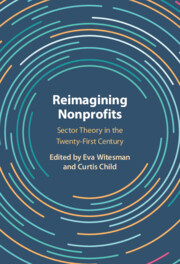Book contents
- Reimagining Nonprofits
- Reimagining Nonprofits
- Copyright page
- Contents
- Figures
- Tables
- Contributors
- Acknowledgments
- 1 An Invitation to Rethink the Nonprofit Sector
- Part I Overviews
- Part II Reflections and Refinements
- Part III New Directions
- 12 Nonprofits as Organizational Actors
- 13 Nonprofits as Enablers of Multilayered Representation
- 14 Nonprofits as Facilitators of National Self-development
- 15 Nonprofits as Part of an Engineered Social Economy
- 16 Nonprofits as Shaped by the Ruling Party
- 17 Nonprofits as Sources of Authoritarian Regime Stability
- 18 Nonprofits as Creators of Transformative Symbolic Reality
- 19 Nonprofits as Distributors of Toll Goods
- 20 Nonprofits as Agents of Moral Authority
- Part IV Conclusion
- Index
- References
12 - Nonprofits as Organizational Actors
from Part III - New Directions
Published online by Cambridge University Press: 11 January 2024
- Reimagining Nonprofits
- Reimagining Nonprofits
- Copyright page
- Contents
- Figures
- Tables
- Contributors
- Acknowledgments
- 1 An Invitation to Rethink the Nonprofit Sector
- Part I Overviews
- Part II Reflections and Refinements
- Part III New Directions
- 12 Nonprofits as Organizational Actors
- 13 Nonprofits as Enablers of Multilayered Representation
- 14 Nonprofits as Facilitators of National Self-development
- 15 Nonprofits as Part of an Engineered Social Economy
- 16 Nonprofits as Shaped by the Ruling Party
- 17 Nonprofits as Sources of Authoritarian Regime Stability
- 18 Nonprofits as Creators of Transformative Symbolic Reality
- 19 Nonprofits as Distributors of Toll Goods
- 20 Nonprofits as Agents of Moral Authority
- Part IV Conclusion
- Index
- References
Summary
Bromley and Santos make a cultural argument that situates nonprofit organizations within the broader context of organization itself. Due to the ascendancy of organization as an emergent category of social structure, the authors suggest that all types of organizations (government, business, nonprofit) are becoming increasingly similar. As the divisions between them (e.g., for-profit organization vs. nonprofit organization, etc.) become less prominent, the sector in need of explanation is the organizational one, writ large. Thus, rather than explaining the nonprofit sector, per se, the authors argue that the nonprofit sector is just one manifestation of organization and that it is organization that deserves our attention. In this sense, sector theory as traditionally understood (as narrow attention to the nonprofit sector in comparison to other sectors) diverts attention from more fundamental sociocultural developments. The authors argue that one can only understand nonprofit organizations vis-à-vis government and for-profit organizations by first understanding this broader context.
Keywords
- Type
- Chapter
- Information
- Reimagining NonprofitsSector Theory in the Twenty-First Century, pp. 233 - 250Publisher: Cambridge University PressPrint publication year: 2024



